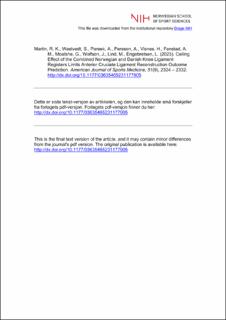| dc.contributor.author | Martin, R. Kyle | |
| dc.contributor.author | Wastvedt, Solvejg | |
| dc.contributor.author | Pareek, Ayoosh | |
| dc.contributor.author | Persson, Andreas | |
| dc.contributor.author | Visnes, Håvard | |
| dc.contributor.author | Fenstad, Anne Marie | |
| dc.contributor.author | Moatshe, Gilbert | |
| dc.contributor.author | Wolfson, Julian | |
| dc.contributor.author | Lind, Martin | |
| dc.contributor.author | Engebretsen, Lars | |
| dc.date.accessioned | 2023-09-13T11:22:21Z | |
| dc.date.available | 2023-09-13T11:22:21Z | |
| dc.date.created | 2023-06-09T10:16:11Z | |
| dc.date.issued | 2023 | |
| dc.identifier.citation | American Journal of Sports Medicine. 2023, 51(9), 2324-2332. | en_US |
| dc.identifier.issn | 0363-5465 | |
| dc.identifier.uri | https://hdl.handle.net/11250/3089144 | |
| dc.description | I Brage finner du siste tekst-versjon av artikkelen, og den kan inneholde ubetydelige forskjeller fra forlagets pdf-versjon. Forlagets pdf-versjon finner du på journals.sagepub.com / In Brage you'll find the final text version of the article, and it may contain insignificant differences from the journal's pdf version. The original publication is available at journals.sagepub.com | en_US |
| dc.description.abstract | Background: Clinical tools based on machine learning analysis now exist for outcome prediction after primary anterior cruciate ligament reconstruction (ACLR). Relying partly on data volume, the general principle is that more data may lead to improved model accuracy. Purpose/Hypothesis: The purpose was to apply machine learning to a combined data set from the Norwegian and Danish knee ligament registers (NKLR and DKRR, respectively), with the aim of producing an algorithm that can predict revision surgery with improved accuracy relative to a previously published model developed using only the NKLR. The hypothesis was that the additional patient data would result in an algorithm that is more accurate. Study Design: Cohort study; Level of evidence, 3. Methods: Machine learning analysis was performed on combined data from the NKLR and DKRR. The primary outcome was the probability of revision ACLR within 1, 2, and 5 years. Data were split randomly into training sets (75%) and test sets (25%). There were 4 machine learning models examined: Cox lasso, random survival forest, gradient boosting, and super learner. Concordance and calibration were calculated for all 4 models. Results: The data set included 62,955 patients in which 5% underwent a revision surgical procedure with a mean follow-up of 7.6 ± 4.5 years. The 3 nonparametric models (random survival forest, gradient boosting, and super learner) performed best, demonstrating moderate concordance (0.67 [95% CI, 0.64-0.70]), and were well calibrated at 1 and 2 years. Model performance was similar to that of the previously published model (NKLR-only model: concordance, 0.67-0.69; well calibrated). Conclusion: Machine learning analysis of the combined NKLR and DKRR enabled prediction of the revision ACLR risk with moderate accuracy. However, the resulting algorithms were less user-friendly and did not demonstrate superior accuracy in comparison with the previously developed model based on patients from the NKLR alone, despite the analysis of nearly 63,000 patients. This ceiling effect suggests that simply adding more patients to current national knee ligament registers is unlikely to improve predictive capability and may prompt future changes to increase variable inclusion. | en_US |
| dc.description.abstract | Ceiling Effect of the Combined Norwegian and Danish Knee Ligament Registers Limits Anterior Cruciate Ligament Reconstruction Outcome Prediction | en_US |
| dc.language.iso | eng | en_US |
| dc.subject | acl revision | en_US |
| dc.subject | outcome prediction | en_US |
| dc.subject | machine learning | en_US |
| dc.subject | artificial intelligence | en_US |
| dc.title | Ceiling Effect of the Combined Norwegian and Danish Knee Ligament Registers Limits Anterior Cruciate Ligament Reconstruction Outcome Prediction | en_US |
| dc.title.alternative | Ceiling Effect of the Combined Norwegian and Danish Knee Ligament Registers Limits Anterior Cruciate Ligament Reconstruction Outcome Prediction | en_US |
| dc.type | Peer reviewed | en_US |
| dc.type | Journal article | en_US |
| dc.description.version | acceptedVersion | en_US |
| dc.source.pagenumber | 2324-2332 | en_US |
| dc.source.volume | 51 | en_US |
| dc.source.journal | American Journal of Sports Medicine | en_US |
| dc.source.issue | 9 | en_US |
| dc.identifier.doi | 10.1177/03635465231177905 | |
| dc.identifier.cristin | 2153248 | |
| dc.description.localcode | Institutt for idrettsmedisinske fag / Department of Sport Sciences | en_US |
| cristin.ispublished | true | |
| cristin.fulltext | postprint | |
| cristin.qualitycode | 2 | |
